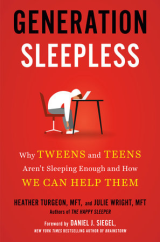Excerpted from “Generation Sleepless” (Penguin, 2022) by Heather Turgeon and Julie Wright.
Little kids and teenagers model their behaviors (often subconsciously) after their parents, so if your phone is an appendage and your attention is continually drawn to it, this behavior pattern is more likely to be adopted by your kids. When you practice basic boundaries and good screen habits, this also rubs off on the whole family. Not only that, it signifies to your teen that your own sleep and well-being are a priority.
 Parents
have room for improvement in this arena: the majority of parents say
they sleep with a mobile device next to their bed, and about 1 in 4 say
they wake up to check their phone in the night. If you ask children
about their parents’ screen behaviors, many will express disdain for the
phone and say their mom or dad is always on it, and it’s hard to get
their attention. Half of adolescents say their parent or caregiver is
distracted by their cell phone when they’re trying to have a
conversation with them.
Parents
have room for improvement in this arena: the majority of parents say
they sleep with a mobile device next to their bed, and about 1 in 4 say
they wake up to check their phone in the night. If you ask children
about their parents’ screen behaviors, many will express disdain for the
phone and say their mom or dad is always on it, and it’s hard to get
their attention. Half of adolescents say their parent or caregiver is
distracted by their cell phone when they’re trying to have a
conversation with them.
Most parents are aware that babies and little kids need our attention, but we don’t appreciate how much teenagers do, too. They pick up on signs of distraction, like when our eyes are glued to a screen, when it takes many attempts to get our attention, or when we pick up our phones in every down moment as if the device is more interesting than the moment in front of us. It’s a huge relief to kids when we watch and listen. It makes them feel seen, validated, and understood. This is not just something we save for a big moment of “Hey, Mom, I need to talk to you.” Rather, teens pick up on our nuanced distraction all the time. In addition, if you regularly talk, text, and type in designations on your phone while you’re driving, your teen won’t take you seriously when you tell him how dangerous distracted driving is.
The irony is that parents are much more likely to turn to their phone when a child is acting out or a teen is non-responsive or withdrawn, creating a further breakdown in communication when they need us most. In these difficult moments, it’s easier to retreat to our corners and not to deal with what’s going on under the surface. It makes perfect sense that our instinct is to distract ourselves from the reality of how hard these moments can feel, but as we grow the habit of escaping to our screens, we get rustier and rustier at effective communication with our kids. By not giving up and turning to your own devices, you are refusing to be influenced by a force, created by technology, that is carrying you further and further from your teen.
The antidote to this powerful pull of technology is two-fold. One, healthy screen habits, and two, the broader family elements that lead to greater well-being, connection, and sleep. We think of these elements like daily vitamin doses that keep everyone F-O-N-D of each other:
Family rituals: Teenagers grow more independent, but they continue to need the primary attachment to family. As kids get older, it’s important to protect the rituals of dinner together, movie night, Sunday morning hikes or throwing a baseball, bedtime routines, and so forth. Rituals are different from spontaneous times together, which are important too, because they are predictable and lead to a feeling of belonging and security. Too often we see families grow disconnected from each other while living under the same roof, and this is accentuated by electronic media. Research has found that kids who spent more time on non-screen activities, like in-person social interactions, sports or exercise, print media, and attending religious services, were less likely to have mental health issues. These real-world routines and rituals have clear benefits and help our kids grow a healthy sense of self, purpose, and connection to our family and community.
Open play: Play is an intrinsic human drive and it’s essential to the brain. Through play, kids learn to solve problems, stretch creativity, sustain attention, and feel joy, satisfaction, and accomplishment. The trouble is that play (of the non-digital variety) can easily disappear as kids get older. Most people know that little kids need to play, but as they mature, we respect this need less and less. Psychologist Stuart Brown has researched play for decades, finding many connections between play (at all ages) and our happiness and fulfillment as individuals, resilience, flexibility and connection to each other as social beings. And says, “Nothing lights up the brain like play,” says Brown. What constitutes play is that it’s done for enjoyment and exploration (not necessarily an organized sport). Building a model robot, finding random materials to make a hangout spot, climbing a hill and rolling down, or just riding bikes around the neighborhood are examples. “The opposite of play is not work,” says Brown. “It’s depression.” Play is a component of happiness and it leads our kids, teens, and us as adults to feel better regulated, connected, and healthier — it’s basically an antidepressant, and should be protected as kids get older. Play — especially outdoors — improves our sleep. What’s amazing is how natural the drive is to play, so promoting it does not have to be fancy at all. All you need is the opportunity for play: time and space away from screens. When kids are together, without screens, they play together instinctively (as they get older, they just need a little warm up time). Don’t worry about the complaints of being bored or the resistance to getting outside. With time, the drive to play takes over.
Nature: Being in nature has been found to lower levels of stress hormones (which also helps us sleep), increase cognitive abilities, and improve mood. One study found that gardening for thirty minutes significantly reduced stress chemicals, even more than reading for the same amount of time. Another found that walking in nature reduced activity in the part of the brain responsible for rumination (continuously thinking about something that bothers you). Sunlight early in the day stimulates the brain to become alert, increases mood-improving neurochemicals, and deepens our sleep in the forthcoming night.
Downtime: If every moment of your day is accounted for, there is no opportunity to become bored, have a new idea or a spontaneous experience that isn’t pre-scripted. Downtime is easily squeezed by busy family life, but we find it helps everyone feel better when there’s some downtime built into each week. It sounds counterintuitive to schedule downtime, but that’s what most families need to do, and it works well.
The combination of healthy screen habits and F-O-N-D family elements improves sleep by feeding family connection, fun, and meaning, as well as keeping us in control of our devices, so we can enjoy their benefits, and then put them away.

Heather Turgeon and Julie Wright are psychotherapists, sleep specialists and authors of the popular parenting books, "The Happy Sleeper" and "Now Say This." Their work has appeared in The New York Times, The Wall Street Journal, The Atlantic, The Washington Post and on several NPR shows. Turgeon lives in Los Angeles and has a (well-rested) tween and teen. Wright is the creator of one of LA’s best known parenting programs, The Wright Mommy and Me. She lives in New York City and has a young adult son.




